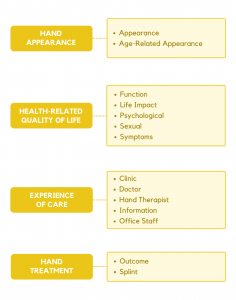Research
Field-tested in sample of 1277 patients with any type of congenital and acquired hand conditions.
HAND-Q scales were developed from 62 concept elicitation interviews with people with any type of congenital or acquired condition affecting the hands. To establish content validity, we conducted 20 cognitive interview and obtained input from 25 international experts. The HAND-Q was then field-tested in an international sample of 1277 patients from 6 countries.

The HAND-Q includes 14 independently functioning scales that measure 4 overarching domains. The variety of scales provides flexibility to choose the subset of scales best suited to measure the outcomes of interest in any given study or clinical situation.
Field-tested in sample of 1277 patients with any type of congenital and acquired hand conditions.
Can be used in international clinical trials of hand treatments.
Can be used to benchmark outcomes in quality improvement initiatives.
Designed using a modern psychometric approach to facilitate use in patient care.
The HAND-Q is a rigorously developed patient-reported outcome (PRO) measure that can be used internationally to collect and compare evidence-based outcomes data from patients with any type of congenital or acquired hand condition. The HAND-Q measures 4 overarching domains. Each domain is composed of 1 or more independently functioning scales. Clinicians and researchers are able to administer the subset of scales relevant to their situation.
Two scales measure appearance of the hands. One scale is relevant to anyone with a hand condition that affects appearance. The other includes content that is age-related and could be used to evaluate the outcome of anti-aging treatments (eg, fillers).
Five scales measure aspects of health-related quality of life. The scales cover hand function and symptoms, life impact, and psychological and sexual well-being.
Five scales measure patients’ experience of healthcare. One scale measures satisfaction with hand surgery information. The other 4 scales measure satisfaction with the healthcare team (i.e., doctor/surgeon, hand therapist, and office staff) and hand clinic.
One scale measures satisfaction with a hand splint or brace. Items ask how easy the splint is to remove, how comfortable it feels to wear, and the ability to do various activities with the splint on. The other scale measures satisfaction with outcome of treatment.




